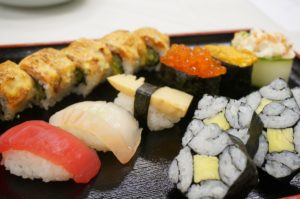Japanese cuisine is becoming increasingly popular everywhere, pleasing more and more palates, from young children to the elderly. But one question that often causes uncertainty among parents who love these dishes is: can children eat Japanese food?
Dishes are not always cooked, or more specifically, are prepared with raw fish, which can pose some risk for babies and children, so it’s always good to clear up any doubts before serving.
At What Age Can You Eat Raw Fish?
The general answer is yes! Children can go to Japanese restaurants with their families and eat Japanese dishes. The only recommendation is that children under the age of 3 should not eat dishes that include raw fish as an ingredient.
Choose cooked or grilled dishes. Usually, there is a variety of options specifically to cater to children and people who do not like the famous raw fish.
Also, pay attention to the sodium content in some foods from Japanese cuisine. Watch what your children are eating. Remember, it’s always important to be careful not to overdo it.
Usually, in Japanese restaurants, there are menu options suitable for children’s tastes, such as yakisoba, chicken strips, and even grilled fish, which are quite popular among kids.
Good Hygiene of the Establishment
Even with all the care in food selection, it’s worth highlighting the importance of hygiene at the establishment. Because the food is prepared fresh and much of it uses raw fish, it should be fresh and made in an impeccably clean kitchen by a qualified professional1.
Some places offer an open counter so customers can watch the food being prepared. This way, you can check out the entire kitchen. Remember, eating contaminated fish can cause serious health problems. Try to bring your family only to reputable places with good references.
Trying foods that we’re not used to offering in our daily lives can be very pleasurable. New flavors, new colors, and textures are always welcome, but we should always be careful about the risks some foods may pose.
When Can You Give Chocolate to a Child?
When it comes to chocolate, it’s a tough subject for everyone. Who can resist, right? Chocolate is one of the most tempting foods in the world, and it can become quite addicting once it’s been tasted.
Some parents avoid giving sweets to their children and remain strict especially when it comes to chocolate. But how long should you wait? When can you give chocolate to your child without risking allergies or other problems?
It’s hard to stop a child from eating chocolate, especially when they are already attending kids’ parties full of brigadeiros of all shapes and colors. The curiosity to try what everyone else is eating is inevitable.
Actually, there is no exact age for offering chocolate. Of course, the longer you can hold off the better, after all, sugar is not necessary for a child’s life. But when you do offer it, give a small amount and be alert to allergies.
There are many types of chocolate on the market. White, dark, with nuts, filled, milk, or bittersweet. For the first taste, we recommend giving plain chocolate without fillings, since other types may contain dyes and cause allergies.
Some children may have an allergic reaction2 to cocoa and develop itching and redness right after eating. So, choose plain chocolate at first. For older children, the amount should also be controlled, since chocolate, besides sugar, contains a large amount of fat. Consuming too much can cause diarrhea and severe stomach pain.
Giving chocolate to a child is a road of no return! It’s rare to find a child who doesn’t like this delicious treat. Believe it, chocolate is addictive! We must not forget that too much chocolate is bad for you, just like any other food when consumed in excess3. If you’re going to let your child eat chocolate, enjoy a small portion and always take care of your own health and your children’s health.
See Also: Foods Not Recommended for Babies
Photo: pxhere












